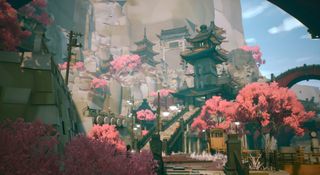Tasomachi is a chill platformer by a veteran game artist with credits on Zelda and Final Fantasy
Puzzly platforming with a lush art style.

You may not have heard of an artist called Nocras before, but if you play a lot of Japanese games you might have encountered his work without realising it. In the past he's provided 2D and 3D art for games including The Legend of Zelda: Breath of the Wild, Final Fantasy XIV, and Xenoblade Chronicles 2, to name just a few. But now Nocras is turning his hand to game development with Tasomachi: Behind the Twilight, a 3D puzzle/platformer that looks—as you might expect from a veteran game artist like Nocras—very pretty indeed.
"I enjoy making 2D and 3D art for myself and others," he says. "But I felt a need to express myself and the beauty of the world, which I could only do properly through a videogame of my own." In the spirit of classic 3D platformers, a big part of Tasomachi is collecting items hidden around its serene Ghibli-esque world. "It feels like the world unfairly abandoned the collect-a-thon platformer," says Nocras. "I wanted to bring the genre back with beautiful visuals that create the same sense of melancholy and joy that I originally felt in my youth."
In Tasomachi you play as an explorer, Yukumo, whose airship crashes in a mysteriously abandoned village covered in a mysterious, supernatural mist. With the help of cat-like creatures called Nezu, she works to clear the fog, and repair her broken down airship, by solving puzzles, completing platforming challenges, and hunting for hidden items. These items, called Sources of Earth, appear as glowing lanterns. Some are easy to find; others are more cleverly hidden, requiring thorough exploration of the town and surrounding areas.
Refreshingly, there are no enemies in Tasomachi, nor any combat. The focus here is squarely on exploration and discovery, which gives it a nice, laid back feel. The music is fantastic too, with a chill, dreamy soundtrack composed by Japanese musician Ujico. The whole vibe is just extremely nice.
Even the Sanctuaries—platforming sections you have to complete to drive the mist away and progress to other parts of the world—are never that taxing. There are a few trickier sections here and there, but mostly the game resists throwing anything too frustrating at you. It helps that Yukumo only has a handful of moves—a dash, a drop, and a jump—which means you don't have to wrestle with any complicated controls or constantly learn new abilities.

The downside of this is that Tasomachi can feel too simplistic at times. The character movement is very basic, with no real sense of weight or momentum. The rudimentary UI feels weirdly placeholder—especially when everything else in the game looks so nice. I couldn't find any graphics settings; just the option to change my resolution. And some of the transitions between animations are clumsy and robotic. The game looks lavish, but it feels kinda cheap.
Even so, there's something very compelling about it. The world is captivating enough that the desire to see more of it occasionally outweighs its shortcomings. Tasomachi is being released via Steam and GOG on April 14, and it might be worth a look if the things you enjoy most about 3D platformers are exploration and sniffing out hidden items, not bouncing on heads.
The biggest gaming news, reviews and hardware deals
Keep up to date with the most important stories and the best deals, as picked by the PC Gamer team.
If it’s set in space, Andy will probably write about it. He loves sci-fi, adventure games, taking screenshots, Twin Peaks, weird sims, Alien: Isolation, and anything with a good story.
Most Popular

